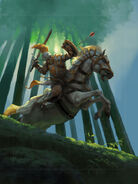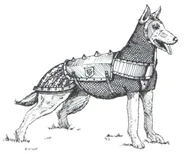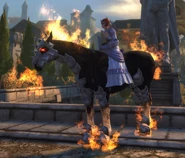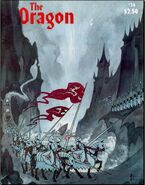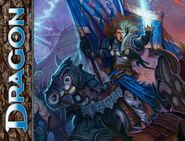Barding was a general term for armor designed to be worn by mounts. It was most often designed for horses, though people were known to make barding for plenty of other mountable creatures in the Realms,[1] as well as some tauric races.[13]
Description[]
Barding offered protection for mounts, though it came at many costs. Wearing barding typically inhibted a mount's speed and maneuverability as well as made them tire out more quickly. Because of this, it was typically used only on large and powerful mounts.[1] Typically the most protective armors were some of the heaviest. When equipped with barding a mount needed to be given special attention, making sure that it didn't chafe them or make them sore.[14]
Availability[]
Much like standard armor, barding was typically made by armorers. Though shieldsmiths were often capable of making adequate barding.[15] Many common men lacked barding for their horses as it could be very expensive.[1]
History[]
Following the development of barding for horses, many in the Realms sought to breed stronger horses that would be capable of both wearing barding and carrying an armored rider. Over time this mount armor paralleled the development of armor for humanoids and other races, centered around the conundrum of obtaining better flexibility and a lighter weight whilst not sacrificing protection.[1]
Scale barding first became available in Netheril in 1080 NY (−2779 DR). In 1373 NY (−2486 DR), chain barding became available in Netheril. And in 3205 NY (−654 DR), plate barding became available in Netheril.[16]
When King Azoun IV of Cormyr lead an alliance of nations throughout Faerûn against the Grand Army of the Tuigan in 1360 DR, the fighting men of his own nation had varying degrees of barding. The wealthier nobles generally had full plate barding for their horses, while nobles of lesser means had either banded or full scale mail. The standard Cormyrian troop had either chain or leather barding for their horse.[17]
In the late-15th century DR, when corsairs from Luskan fought against explorers from Delzoun for control of Gauntlgrym they utilized barding on howler mounts.[18]
Variations[]
Some types, known as half barding and partial barding, only offered partial protection for a mount. The former in particular only covered the front and forward sides of an animal. These types of barding were not the same thing as simply removing some of a mount's full barding — they were specially formed, fitted, and balanced for protection.[19] Half barding was far more common than full in warmer or humid climates. In such regions, light full barding was most commonly used.[1]
Barding came in a wide variety of materials and types similar to those armor worn by humanoid races. These included the following:[7]
Light Barding[]
- Leather Barding: Equivalent to leather armor, this was one of the most commonly used forms of barding.[20] People often reinforced it with parts made of either steel bands, wooden planks, or short strips of thick hard wood.[1]
- Padded Barding: Comparable to leather in its protection, this barding was made of thickly padded quilted cloth.[20]
- Wicker barding: Comparable to wicker armor, one of the cheapest forms of armor. They were constructed of tightly woven reeds. Sometimes clever armorsmiths could weave thorns into them.[21]
Medium Barding[]
- Brigandine barding: Equivalent to brigandine armor, this composite type of barding consisted of small bands of metal sandwiched between layers of leather. It was typically the most advanced type of barding a simple village armorer could forge.[22]
- Chain barding: Equivalent to chain mail, this was one of the most commonly used forms of medium barding. It was equipped in sections, with the main pieces either attached to the saddle or laid over the mount and buckled underneath. A heavy cloth or blanket was typically placed underneath in order to prevent rubbing and abrasions, which would more quickly fatigue a mount.[22]
- Elven chain barding: Equivalent to elven chain mail, this was an extremely rare type of barding that was generally unavailable to anyone other than elven nobility.[22]
- Ring barding: Equivalent to ring mail, this type of barding was composed of metal rings sewn into a heavy cloth or leather backing.[22]
- Scale barding: Equivalent to scale mail,[22] this was an early form of medium barding that was superseded by chain barding in more advanced regions.[20]
- Studded leather barding: Equivalent to studded leather and roughly equal in protection to ring barding, this early form of barding consisted of layers of soft leather reinforced with many small metal studs. Sometimes these studs were long and filed to a point.[22]
Heavy Barding[]
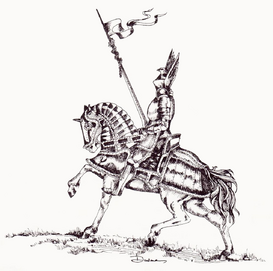
A paladin rides upon a horse decked out in full splint barding.
- Banded barding: Equivalent to banded mail, this type of barding was similar to the chain variety, though it was reinforced with horizonal strips of metal.[23]
- Lamellar barding: Equivalent to lamellar armor, a heavy type of scale mail that was unique to the land of Zakhara.[24]
- Plate barding: Equivalent to plate mail, this type of barding was made from chain mail and small steel plates linked together and hinged with articulated joints. A thick padded or quilt cloth, equipped with metal studs, was typically placed across it.[23]
- Splint barding: Equivalent to splint mail, this type of barding was similar to the banded variety, though the metal strips that reinforced it were vertical instead of horizonal.[23]
Notable Users of Barding[]

Knights of the Gauntlet ride forth on horses in partial plate barding.
Creatures[]
- Camels were almost never equipped with barding as it reduced their carrying capacity, made them harder to control, and generally hindered their abilities far more than it did horses.[1]
- Elephants were sometimes outfitted with leather or metal barding.[1]
- Unique barding existed for thunderherders.[25]
- War dogs were occasionally outfitted with barding.[19]
- Worgs were occasionally outfitted with barding.[19]
Groups[]
- The Zhentarim forces of the Citadel of the Raven and Zhentil Keep typically had plate barding for their horses.[26][27]
- Wandering rogues, highwaymen, and occasionally adventurers were all known to use half-brigandine barding on their mounts.[22]
Individuals[]

Dalthyria of the Fangshields shows off specialized centaur chain barding.
- Buck, a mastiff belonging to the operators of Iron Bull Smithy, was sometimes outfitted with chain mail barding and a steel cap.[28]
- Deng Tse Chin
- Glawinn
- Keinen
- Randers
- Savage and Carnage, the canoloth pets of Inthracis, were both outfitted with spiked plate barding.[29]
- Timoth Eyesbright would often wear barding.[30]
- Tusk, the fiendish elephant pet of Kurgoth Hellspawn, typically wore chain barding.[31]
Races & Intelligent Creatures[]
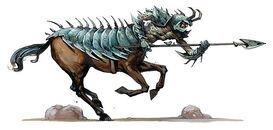
An armanite charges into battle while wearing barding.
- Armanites typically wore full plate barding that was constructed of demonic chitin.[32]
- Bariaurs wore scale barding whenever they went into combat.[33]
- Centaurs wore specialized barding that was a combination of humanoid armor and standard barding.[13]
- Some lamias wore barding.[34]
- Dwarves and gnomes generally were not known to use barding on mounts, though they occasionally made leather ones for their pack animals.[35]
- Elves and humans were the races that most often utilized barding for mounts.[1]
- Elves and halflings occasionally used thick padded cloth and leather barding on their pony and light horse mounts respectively.[35]
- Many humanoid races were known to use studded leather barding.[22]
- Successful bands of goblins and orcs would equip their mounts with half-scale barding.[22]
- On the planet of Oerth, chain barding was commonly used by grey elf cavalry companies.[22]
Regions, Nations, and Settlements[]

A Blade Captain of the Blade Kingdoms rides on a horse garbed in full barding.
- Poor or less civilized cultures primarily used padded cloth barding.[35]
- The use of barding in Kara-Tur varied across the land, though generally it was lighter weight than those of Faerun and was used by important nobles, generals, and shock troops. Half-barding was more frequently used than full-barding. And the most commonly used types were brigandine, chain, leather, leather scale, and padded. Plate barding was almost never used.[36]
- During the days of the Empire of Netheril the barding available to its inhabitants were chain, plate, and scale. Brigandine barding in particular, was known to have never been available to them.[16]
- Studded leather barding was commonly used in the regions of Amn, Narfell, Shaar, the Hordelands,[37][38] and the Ride.[38]
- In the land of Zakhara, the types of barding most commonly used were lamellar, padded, and wicker. Camels were only ever decked out in padded barding. Full and half versions of these could be found offered in bazaars for both elephants and horses, as well as full chain barding for horses.[5]
Appendix[]
Notes[]
- ↑ An exact value for these bardings was not listed in the Player's Handbook v.3.5. Rather, it stated that barding for medium creatures was twice that of their humanoid equivalent and that the value of barding for large ones was four times that.
- ↑ An exact weight for these bardings was not listed in the Player's Handbook v.3.5. Rather, it stated that barding for medium creatures was the same weight as its humanoid equivalent and that the value of barding for large ones was twice that amount.
- ↑ An exact price and weight for these bardings was not listed in the Player's Handbook 5th edition. Rather, it stated that the value is twice that of playable armor and four times the weight.
Appearances[]
Adventures
Novels & Short Stories
Video Games
Gallery[]
References[]
- ↑ 1.0 1.1 1.2 1.3 1.4 1.5 1.6 1.7 1.8 1.9 Grant Boucher, Troy Christensen, Jon Pickens, John Terra and Scott Davis (1991). Arms and Equipment Guide. (TSR, Inc.), p. 41. ISBN 1-56076-109-1.
- ↑ Gary Gygax, David Cook, and François Marcela-Froideval (1985). Oriental Adventures. (TSR, Inc), p. 40. ISBN 0-8803-8099-3.
- ↑ 3.0 3.1 Richard Baker, Skip Williams (1995). Player's Option: Combat & Tactics. (TSR, Inc), p. 150. ISBN 0-7869-0096-2.
- ↑ slade et al (December 1994). Encyclopedia Magica Volume I. (TSR, Inc.), pp. 157–158. ISBN 1560768428.
- ↑ 5.0 5.1 5.2 5.3 5.4 Jeff Grubb and Andria Hayday (April 1992). Arabian Adventures. (TSR, Inc), pp. 87–88. ISBN 978-1560763581.
- ↑ Aaron Allston (1989). The Complete Fighter's Handbook. (TSR), p. 6. ISBN 978-0880387798.
- ↑ 7.0 7.1 Grant Boucher, Troy Christensen, Jon Pickens, John Terra and Scott Davis (1991). Arms and Equipment Guide. (TSR, Inc.), pp. 41–45. ISBN 1-56076-109-1.
- ↑ 8.0 8.1 8.2 8.3 James Wyatt (October 2001). Oriental Adventures (3rd edition). (Wizards of the Coast), p. 76. ISBN 0-7869-2015-7.
- ↑ 9.0 9.1 9.2 9.3 Eric Cagle, Jesse Decker, Jeff Quick, and James Wyatt (March 2003). Arms and Equipment Guide 3rd edition. (Wizards of the Coast), p. 15. ISBN 978-0-7869-2649-7.
- ↑ Jonathan Tweet, Monte Cook, Skip Williams (July 2003). Player's Handbook v.3.5. (Wizards of the Coast), pp. 123, 131. ISBN 0-7869-2886-7.
- ↑ Logan Bonner, Eytan Bernstein, & Chris Sims (September 2008). Adventurer's Vault: Arms and Equipment for All Character Classes. (Wizards of the Coast), p. 14. ISBN 978-07869-4978-6.
- ↑ Mike Mearls, Jeremy Crawford (2014). Player's Handbook 5th edition. (Wizards of the Coast), pp. 145, 155. ISBN 978-0-7869-6560-1.
- ↑ 13.0 13.1 Reynolds, Forbeck, Jacobs, Boyd (March 2003). Races of Faerûn. (Wizards of the Coast), p. 134. ISBN 0-7869-2875-1.
- ↑ Jonathan Tweet, Monte Cook, Skip Williams (July 2003). Player's Handbook v.3.5. (Wizards of the Coast), pp. 112–113. ISBN 0-7869-2886-7.
- ↑ Ed Greenwood (February 1983). “The Smith: Test the metal of this NPC”. In Kim Mohan ed. Dragon #70 (TSR, Inc.), p. 7.
- ↑ 16.0 16.1 slade, Jim Butler (October 1996). “The Winds of Netheril”. In Jim Butler ed. Netheril: Empire of Magic (TSR, Inc.), p. 31. ISBN 0-7869-0437-2.
- ↑ Curtis M. Scott (1991). Horde Campaign. (TSR, Inc), p. 54. ISBN 1-56076-130-X.
- ↑ Cryptic Studios (June 2013). Neverwinter. Perfect World Entertainment.
- ↑ 19.0 19.1 19.2 Grant Boucher, Troy Christensen, Jon Pickens, John Terra and Scott Davis (1991). Arms and Equipment Guide. (TSR, Inc.), p. 42. ISBN 1-56076-109-1.
- ↑ 20.0 20.1 20.2 Grant Boucher, Troy Christensen, Jon Pickens, John Terra and Scott Davis (1991). Arms and Equipment Guide. (TSR, Inc.), pp. 42–43. ISBN 1-56076-109-1.
- ↑ Eric Cagle, Jesse Decker, Jeff Quick, and James Wyatt (March 2003). Arms and Equipment Guide 3rd edition. (Wizards of the Coast), p. 17. ISBN 978-0-7869-2649-7.
- ↑ 22.0 22.1 22.2 22.3 22.4 22.5 22.6 22.7 22.8 22.9 Grant Boucher, Troy Christensen, Jon Pickens, John Terra and Scott Davis (1991). Arms and Equipment Guide. (TSR, Inc.), p. 44. ISBN 1-56076-109-1.
- ↑ 23.0 23.1 23.2 Grant Boucher, Troy Christensen, Jon Pickens, John Terra and Scott Davis (1991). Arms and Equipment Guide. (TSR, Inc.), p. 45. ISBN 1-56076-109-1.
- ↑ Jeff Grubb and Andria Hayday (April 1992). Arabian Adventures. (TSR, Inc), p. 96. ISBN 978-1560763581.
- ↑ Jennifer Clarke-Wilkes, Bruce R. Cordell and JD Wiker (March 2005). Sandstorm. (Wizards of the Coast), p. 103. ISBN 0-7869-3655-X.
- ↑ Ed Greenwood, Julia Martin, Jeff Grubb (1993). Forgotten Realms Campaign Setting 2nd edition (revised), A Grand Tour of the Realms. (TSR, Inc), pp. 65, 70. ISBN 1-5607-6617-4.
- ↑ Ed Greenwood, Jeff Grubb (August 1987). “Cyclopedia of the Realms”. In Karen S. Martin ed. Forgotten Realms Campaign Set (TSR, Inc.), pp. 31, 92. ISBN 0-88038-472-7.
- ↑ Terence Kemper (January 1995). “The Living City: The Horse Businesses”. In Jean Rabe ed. Polyhedron #103 (TSR, Inc.), p. 13.
- ↑ Paul S. Kemp (February 2006). Resurrection. (Wizards of the Coast). ISBN 0-7869-3981-8.
- ↑ Dale Donovan (April 1998). “Rogues Gallery: The Heroes of Selûne's Smile”. In Dave Gross ed. Dragon #246 (TSR, Inc.), p. 72.
- ↑ James Wyatt (September 2002). City of the Spider Queen. (Wizards of the Coast), p. 76. ISBN 0-7869-1212-X.
- ↑ Mike Mearls, Brian R. James, Steve Townshend (July 2010). Demonomicon. Edited by Scott Fitzgerald Gray. (Wizards of the Coast), p. 105. ISBN 978-0786954926.
- ↑ Jeff Grubb, Bruce R. Cordell, David Noonan (September 2001). Manual of the Planes 3rd edition. (Wizards of the Coast), p. 161. ISBN 0-7869-1850-8.
- ↑ Ed Greenwood (December 1999). “Elminster's Everwinking Eye: A Wayfarers Guide to the Forgotten Realms”. In Erik Mona ed. Polyhedron #139 (TSR, Inc.), p. 16.
- ↑ 35.0 35.1 35.2 Grant Boucher, Troy Christensen, Jon Pickens, John Terra and Scott Davis (1991). Arms and Equipment Guide. (TSR, Inc.), p. 43. ISBN 1-56076-109-1.
- ↑ Gary Gygax, David Cook, and François Marcela-Froideval (1985). Oriental Adventures. (TSR, Inc), p. 50. ISBN 0-8803-8099-3.
- ↑ Ed Greenwood, Sean K. Reynolds, Skip Williams, Rob Heinsoo (June 2001). Forgotten Realms Campaign Setting 3rd edition. (Wizards of the Coast), pp. 30–32. ISBN 0-7869-1836-5.
- ↑ 38.0 38.1 Richard Baker, James Wyatt (March 2004). Player's Guide to Faerûn. (Wizards of the Coast), pp. 12–14. ISBN 0-7869-3134-5.

